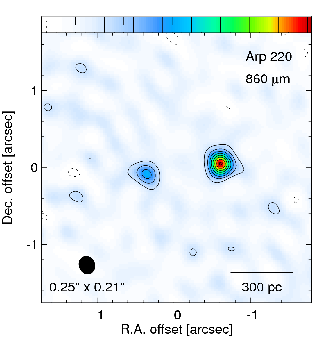|
The Ultraluminous Infrared Galaxy Arp 220 (a case study):
Hidden characteristics of some of the most extreme galaxies in the local universe have been revealed with the SMA through its high-resolution imaging capability in the submillimeter band. Arp 220, the most luminous galaxy within 100 Mpc, has been a focus of attention among galaxy researchers for the last 25 years, partly because it may be an object where an evolution from starburst to quasar is taking place. The SMA has already produced four refereed publications on Arp 220 (Sakamoto et al. 2008, 2009; Matsushita et al. 2009, Aalto et al. 2009). The SMA observations revealed that the two nuclei of the merging galaxy have a bright (luminous) and compact core of dust emission, that there is likely a maser emission feature plausibly excited by the bright continuum, and that the gas around each nucleus is most likely outflowing judging from the molecular absorption features against the bright continuum. All of these are thought to be phenomena that can only be seen in the late phase of galaxy merging, when the merger is most active in terms of star formation or accretion to the central black hole, or both.

| Figure 2: Submillimeter continuum image of the ultraluminous infrared galaxy Arp 220. The two nuclei of the merging galaxy are less than 1" apart on the sky but are clearly resolved with the SMA. The data set a lower limit to the bolometric luminosity of the brighter nucleus, Lbol > 2 x 1011 L⊙ (Sakamoto et al. 2008). |
The strength of the SMA in the study of Arp 220 and similar objects lies mainly in the fact that SMA can produce high-resolution images of dust continuum at wavelengths where the dust emission is nearly opaque (and hence is bright). Since Arp 220 radiates most of its luminosity in the thermal dust continuum from within its central few arcseconds, the high-resolution data of the dust continuum tell us much about the luminosity source. The bright continuum back light also allows us to diagnose gas in the vicinity and in front of the luminous nucleus through line absorption or maser emission. The steep spectral slope of ULIRGs at around 1 mm gives the SMA an edge over millimeter interferometers.
» Next Page: Extragalactic Astrochemistry
« Previous Page
SMA Research
| 